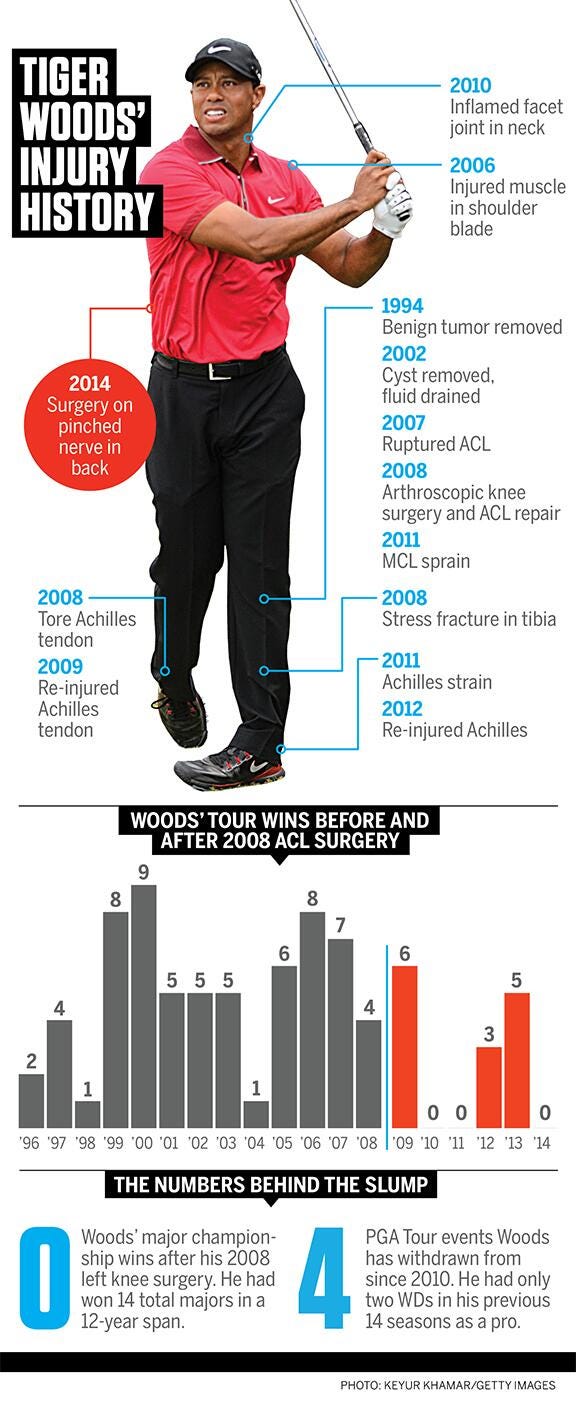Tiger Woods: A Case Study in the Inverse Matthew Effect
The Inverse Matthew Effect is not isolated to Tiger Woods—it's a real phenomenon that athletes across all sports are facing, largely due to neurocentric treatment and training.
The Inverse Matthew Effect
The Matthew Effect explains how athletes who accumulate high levels of physical capital continue to compound their advantages, creating an increasing asymmetry at the Level of Competition. Those at Point B—who possess optimal levels of joint function, reactive strength, absolute strength, and speed strength—are positioned to generate sustained high performance. Over time, this sustained output reinforces itself, further solidifying their dominance. A great example of this is Tiger Woods from 1996 to 2009, whose unmatched physical capabilities allowed him to generate and sustain a level of performance that golf had never seen before.
However, the inverse of the Matthew Effect is just as powerful. When an athlete begins to lose physical capital and drift away from Point B, they enter a compounding negative cycle—a positive feedback loop1 where performance stagnates, injuries accumulate, and their ability to generate, let alone sustain, high-level output rapidly erodes. This phenomenon, which we call the Inverse Matthew Effect, describes how the erosion of Point B capacities triggers a downward spiral, where accommodation and stagnation compound, injuries become more frequent/severe, and performance decline accelerates until the athlete is removed from the level of competition.

Tiger Woods is also a tragic example of this effect. As he moved away from Point B—due to injuries, surgeries, mismanagement of rehabilitation, and ineffective training—he became increasingly constrained by his biological limitations. Specifically from a Point B lens, his loss of joint function and reactive strength prevented him from reattaining the physical state that is the prerequisite for sustained high performance in sport.

Neurological-Biological Asymmetry: Inverse Matthew Effect Amplifier
Looking at Tiger Woods’ injury timeline—though it only extends to 2014—you can see a clear demarcation point where his body began biologically accommodating to the sport of golf. From that moment, stagnation followed rapidly. His injuries became a cascading disadvantage, each one compounding the next in a Doom Loop—a destructive cycle where each injury reduces his ability to accumulate physical capital, further diminishing his competitive output. Just as athletes at Point B experience a positive feedback loop of increasing physical wealth, those who fall below Point B enter a negative feedback loop where injuries and physical limitations accelerate their decline. Most recently, Woods suffered yet another reactive strength injury when he ruptured his Achilles tendon training at home.
This real-life case study highlights a critical Absolute concept: neurological-biological asymmetry—a major amplifier of the Inverse Matthew Effect. This asymmetry occurs when an athlete’s nervous system retains the ability to generate large magnitudes of force at high velocities, but their biology—specifically joint function and the reactive strength of connective tissues—can no longer absorb or transfer that output safely in force transmission scenarios. As a result, the athlete becomes highly vulnerable to catastrophic injury—even in the relative strength sport of golf as witnessed by Woods.
Decreased Joint Workspace & Reactive Strength: The Tiger Woods Example
In Woods’ case, we can safely assume he has consistently lost joint workspace2 in his spine. Years of disc injuries and surgeries have compromised his connective tissue architecture, the bottom-up biological element of reactive strength. Where there was once normal connective tissue architecture, allowing for efficient force transmission, there is now abnormal connective tissue with a significantly lower yield point3—resulting in inefficient, abnormal force transmission. This means it takes far less force and tissue length to cause structural failure and injury.
However, his neurological network of absolute strength still retains the capacity to generate massive magnitudes of force outputs at high velocity—the same force that once allowed him to drive the ball so far that the PGA had to "Tiger-proof" courses by moving tee boxes back.
The problem? A loss of joint function and workspace, combined with a leftward-shifted yield point, means his body can no longer withstand—let alone efficiently transmit—those forces. The moment his nervous system really hits the gas, his biology fails him.
The result? The Inverse Matthew Effect—a cycle of injury, joint and tissue breakdown, and further decline. The neurology that overtook the PGA, forcing them to Tiger-proof the courses, is the same neurology that is now pushing his biology—like his Achilles tendon—past the edge of chaos, where the new order is damaging his body and driving him further and further away from Point B—not towards progress, but towards irreversible joint and tissue breakdown.
Neurology-Biological Asymmetry: A Mechanism of Reactive Strength Injury
Neurological Asymmetry: A Mechanism of Reactive Strength Injury
Neurological-Biological Asymmetry: Inverse Matthew Effects Accelerant
As an athlete drifts away from Point B in joint function and reactive strength, neurological-biological asymmetry becomes an injury accelerant. In Tiger’s case, this mismatch hasn’t just amplified the Inverse Matthew Effect—it has locked him in a doom loop, one that continues to compound and accelerate his physical decline.
The Inverse Matthew Effect is not isolated to Tiger Woods—it's a real phenomenon that athletes across all sports are facing, largely due to neurocentric treatment and training—pracitioners functioning in a neurological paradigm when we have shifted into a reactive strength paradigm. Woods' doom-loop of injuries, much like Christian McCaffrey's recurring setbacks, the NFL’s Billion Dollar Reactive Strength Problem reflects a broader trend—there is a real reactive strength problem across all sports and its costly.
Tiger-Proofing the Biology
Keep reading with a 7-day free trial
Subscribe to Absolute: The Art and Science of Human Performance to keep reading this post and get 7 days of free access to the full post archives.





